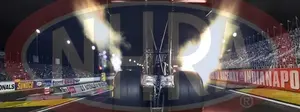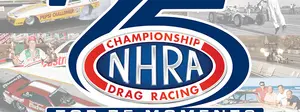

NHRA's Josh Peterson discusses the hows and whys of national event track prep

After a 2017 season in which NHRA’s Top Fuel and Funny Cars broke speed records at tracks across the nation, the NHRA Competition Department took necessary steps early in the 2018 season to head off potential problems caused by the escalating speeds. Adjusting the amount of traction compound applied to the racetrack has not only accomplished that goal but also has produced additional benefits to the sport, as NHRA Vice President-Racing Administration Josh Peterson explains in this interview with NHRA National Dragster magazine.
Why did NHRA decide to adjust the track-prep process?
We had some concerns that came to light with the big speeds last year that needed to be addressed. In 2017, our goal was to provide the best track to provide the best performances possible, but we realized that we couldn’t continue down that path without increasing safety risks. NHRA was founded on the principle of putting safety first. Performance comes second to safety. Unless we are certain that a vehicle can withstand the speeds at which it may perform, we must control the escalation of that speed to protect our drivers and our organization. We cannot in good conscience allow the escalation of speed if there is a chance that we may risk our high standards of safety.
We made some changes at the Winternationals to reduce the amount of track prep at the top end of the track, which seemed to be the root of the problem, but then we reset the [speed] record four times in Phoenix, and speeds were continuing to climb, so we had to make more adjustments, which we did going into Houston.
What has been the feedback from the teams so far?
Some of the teams were skeptical at first, and many of them have had to go back to the drawing board. But drag racing has always been about engineering ingenuity, and the teams are now seeing the benefits from the changes. Ultimately, they all know that we needed to control the escalation of speed, but we’ve also seen some substantial side benefits. The balance of power has leveled out — we’re seeing people like Blake Alexander and Cruz Pedregon winning and guys like Scott Palmer and Shawn Reed reaching their first final rounds — and racing is no longer being dominated by any one or two teams. What we’ve seen is better side-by-side competition where you’re never sure who’s going to win.
The teams have also seen some cost savings in terms of parts consumption. They’re not having to turn the screws as tight as possible because the bigger teams maybe have to tune it down a little to go A to B.
 How do you decide what level of track prep is done and how is it managed?
How do you decide what level of track prep is done and how is it managed?
It’s based on a lot of homework and research that Senior Director of Emergency Services Bob Lang has done. Every track surface is different; the sun hits every racetrack from different angles, the ambient temperature varies, and so on. We monitor and manage it throughout the weekend to keep it at a level that we’re comfortable with. By varying the percentage of traction compound and the speed of the spray rig, we can achieve the desired results.
There are other things, mechanical things, that we as a team — myself, Ned Walliser, Glen Gray, and Tim White — are looking at to control the speeds because we know that the best minds in the sport are going to figure this out, and before long, we could be right back where we started. You can already see the balance of power in Funny Car starting to slip back toward the top teams because they’ve made mechanical changes to adapt to the surface we’re giving them.
Drag racing is about winning, but it also has traditionally been a sport of the pursuit of lower e.t.s and bigger speeds. This seems to go counter to that
Drag racing is not only about breaking barriers. It’s about entertaining, side-by-side drag racing across all of our categories. Look at Pro Stock Motorcycle, where we just broke the 200-mph barrier this year. Drag racing will continue to evolve, and every track is different. We just broke a track record in Norwalk. And it’s exciting to see a car go more than 300 mph every time it happens. Ultimately, it’s about the competition, not the e.t. —- not to mention the unpredictable nature of our sport. We want to create more competition and make competition possible for more drivers. That’s the plan best suited for the health of the sport.
How so?
You can look back at car counts last year, where we were struggling to get full fields. This year, we haven’t had that same problem. The momentum is slowly shifting because the single-car teams know they don’t have to turn the screws to go out and run that quick e.t. or fast mph, and it’s saving those teams that don’t have a vast resource of parts or money to draw on. Even if they’ve decided to pick up only one or two races more, that’s a good thing.




















































